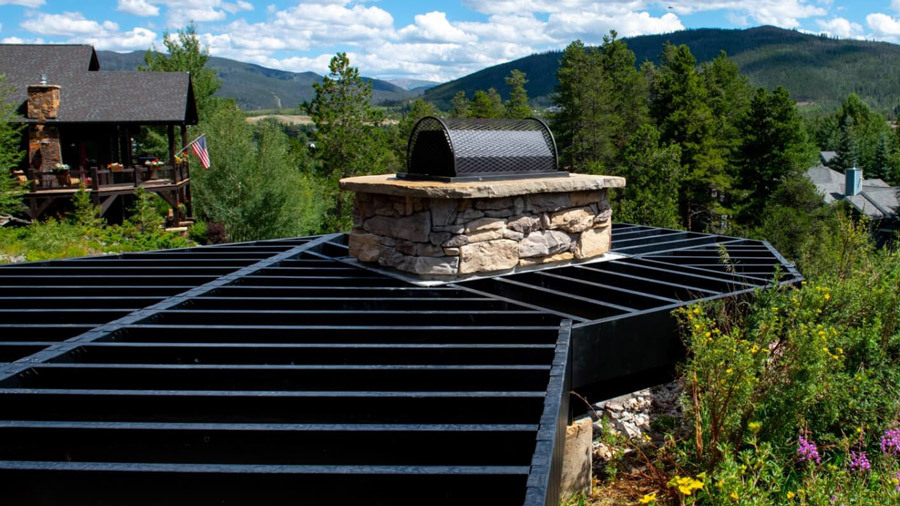A great deck doesn’t have to drain your wallet. Whether you’re looking for inexpensive small deck ideas on a budget or the cheapest way to build a deck, the key is smart planning. With the right materials, a simple design, and a little hands-on effort, you can create an outdoor space that looks great without the jaw-dropping price tag.
Not sure where to start? Read on to learn more, or call our team at 1-888-824-5316 for even more deck design tips.
1. Keep It Simple – Basic Shapes, Basic Savings
The easiest way to keep costs down is to stick to a simple design. A deck with multiple levels, curves, or built-in features might look incredible, but it also burns through your budget fast. The more complex the build, the more materials, labor, and time it takes—all of which add up.
How to Save:
- Stick to a square or rectangle—easier to frame, easier to build, less wasted lumber.
- Match dimensions to standard lumber sizes (think 8, 10, or 12 feet) to cut down on unnecessary cuts and scraps.
- Consider a floating deck if possible—these skip the need for deep footings, making them cheaper and easier to install.
- Limit stairs and railings where possible—both add to material and labor costs.
A simple deck doesn’t mean boring—you can dress it up later with lighting, furniture, or even a built-in bench (we’ll get to that). For now, keep it straightforward and let the savings stack up.
2. Smart Material Choices – Cut Costs Now & Late
Choosing the right materials is where you can either save money upfront or down the road. If you’re looking for inexpensive deck ideas, it’s tempting to grab the cheapest wood possible—but that can lead to higher maintenance costs and a shorter lifespan. Instead, balance cost, durability, and upkeep to get the best value for your budget.
Best Budget-Friendly Decking Options:
- Pressure-Treated Lumber: The go-to for the cheapest way to build a deck, but it requires regular staining and sealing to prevent rot and warping.
- Composite Decking: Costs more upfront, but lasts 20-30 years longer with almost zero maintenance. No staining, no warping, no insect damage—just a one-time investment.
- Mix Materials to Save: Use pressure-treated wood for framing (since it won’t be exposed to the elements) and composite or low-maintenance wood for the surface to get the best of both worlds.
- Concrete Deck Blocks Instead of Poured Footings: If your design allows for it, using deck blocks instead of digging and pouring concrete footings cuts both labor and material costs.
Yes, pressure-treated wood is the cheapest option upfront, but if you plan to own your home for a while, composite might save you money in the long run. Think big picture, and invest where it counts.
Complete Deck Packages at DecksDirect
Shop Low-Maintenance Decking3. Time Your Build – Offseason = Lower Costs
Timing matters more than you think. If you’re planning to hire a contractor or even just buying materials, when you build can make or break your budget. Spring and summer are the busiest seasons for deck building, which means higher prices, longer wait times, and fewer discounts. But if you’re willing to build during the offseason, you can score big savings.
How to Save:
- Buy materials in late fall or winter: Retailers often mark down decking supplies after the peak season to clear inventory.
- Schedule contractors for the slow season: Many deck builders have gaps in their schedule between November and April and may offer lower rates to keep busy.
- Avoid last-minute purchases: Plan ahead and watch for end-of-season sales on decking, fasteners, and railing systems.
If you’re willing to wait a few months, you might knock hundreds (or even thousands) off the total cost. Plus, building outside peak season means less competition for contractors, making scheduling easier and the whole process less stressful.
4. Secure Railings & Handrails – Safety Without Overspending
A deck isn’t complete without sturdy railings and handrails, but that doesn’t mean you have to spend a fortune. Safety should always be a priority, especially if your deck is elevated, but there are smart ways to keep costs down while still meeting code requirements and ensuring durability.
How to Save on Railings:
- Pre-Assembled Railing Kits: These save time and money compared to custom-built railings. They’re designed for easy installation and often come with all the necessary hardware.
- Aluminum or Composite Over Wood: Wood railings might seem cheaper at first, but they require constant maintenance to prevent rot and splintering. Powder-coated aluminum or composite railings cost more upfront but last decades with no upkeep.
- Check out Revival Railing, a brand designed to offer metal railings low-maintenance benefits at a price that can be closer to average wood railings than average metal railings.
- Limit Railings Where Possible: If your deck is low to the ground, you might not need railings at all, depending on local building codes. Keeping the deck height under the requirement for railings can save a major expense.
- DIY the Install: Even if you hire a pro for the deck build, installing railings yourself is one of the easier DIY tasks, especially with pre-assembled kits.
Cutting corners on safety is never worth it, but choosing the right materials and smart design can keep your railing costs low without sacrificing durability or code compliance.
5. Smart Deck Lighting – Affordable Ways to Brighten Your Space
Lighting might not be the first thing on your mind when budgeting for a deck, but planning ahead can save you serious cash. Adding stair and deck lights after the fact means extra labor, tricky wiring, and possibly even removing boards to run cables. Instead, think ahead and choose cost-effective, energy-efficient lighting options that won’t break the bank.
How to Save on Deck Lighting:
- Go Solar Where You Can: Solar deck lights require zero wiring, making them an easy, budget-friendly choice for post caps, steps, and pathways.
- Use Low-Voltage LED Lights: If you need wired lighting, low-voltage LED deck light options are cheaper to run and last much longer than traditional bulbs.
- Pre-Plan Wire Placement: If you’re building from scratch, run conduit or leave access points for wiring while constructing the deck. It’s much easier (and cheaper) than retrofitting later.
- Look for DIY-Friendly Kits: Many deck lighting systems come in plug-and-play kits that don’t require an electrician, saving on labor costs.
A well-lit deck adds safety, ambiance, and usability—but it doesn’t have to drain your budget. Plan early, use solar and low-voltage options, and avoid expensive retrofits to keep costs in check.
How To Hide Deck Lighting Wires
Check out this helpful video on how to hide low-voltage deck lighting wires for a clean, professional look. Keeping wires concealed in railings, posts, or under deck boards not only improves aesthetics but also prevents tripping hazards and weather damage. Watch the step-by-step guide to make your deck lighting safe, seamless, and hassle-free.
Built-In Bench Seating – Budget-Friendly & Functional
Furniture can be surprisingly expensive, and if you’re already spending money on decking materials, why not build seating right into the deck itself? Built-in benches maximize space, eliminate the need for extra chairs, and make the most of leftover materials—all while adding a custom look without a custom price.
Why Built-In Seating Saves Money:
- Uses Extra Decking Materials: If you have spare boards from your build, a bench is a great way to put them to use instead of wasting them.
- Eliminates the Need for Patio Furniture: No need to buy pricey outdoor chairs—your deck comes with built-in seating.
- Doubles as Storage: Add hinged lids to your benches to create hidden storage for cushions, tools, or outdoor gear.
A few simple bench designs can make your deck more functional and stylish while keeping costs low. Whether it’s a corner bench, wraparound seating, or a freestanding unit, built-in benches stretch your budget while enhancing your outdoor space.
7. DIY What You Can, Hire What You Must
One of the biggest ways to cut deck costs is to do as much of the work yourself as possible. Labor is often the most expensive part of a deck build, so if you’re handy with basic tools—or willing to learn—you can save thousands by tackling some of the work yourself. That said, know your limits—some parts of the job are best left to professionals.
Where DIY Can Save You Money:
- Framing & Decking: If you’re comfortable with a drill and a level, installing deck boards and framing can be a DIY-friendly job.
- Railings & Lighting: Many modern railing and lighting kits are designed for DIY installation and don’t require specialized tools.
- Staining & Sealing: If you go with wood, applying stain and sealant yourself saves on contractor fees.
When to Call in a Pro:
- Permits & Inspections: Some areas require professional approval for deck builds, so check your local regulations.
- Structural Footings & Ledger Boards: A poorly installed ledger board or footing can lead to a wobbly or unsafe deck, so if you're unsure, hire a pro.
- Complex Designs & Multi-Level Decks: If you’re going beyond a simple platform deck, consider bringing in a contractor to ensure safety and durability.
A DIY deck on a budget is absolutely doable—just be strategic about what you tackle yourself and when to bring in expert help. If you need guidance on what you can realistically DIY, call DecksDirect at 1-888-824-5316 to talk through your project.
Frequently Asked Questions: Inexpensive Deck Ideask
If you want to learn more inexpensive deck ideas, feel free to check out our helpful FAQ down below!
What’s the cheapest way to add shade to a deck?
Instead of a pricey pergola or retractable awning, use a shade sail, outdoor curtains, or a patio umbrella for affordable sun protection. A DIY trellis with climbing plants can also create shade while adding a natural touch to your deck.
How can I make a small deck feel bigger?
Multi-purpose features like built-in seating, lighter-colored deck boards, and minimalist railings help open up the space. Arranging furniture smartly—like placing chairs against the railing—maximizes floor space without making the deck feel cramped.
Can I build a deck without digging post holes?
Yes! Floating decks and deck blocks allow you to build a sturdy deck without deep footings. These options save money on concrete and labor while making DIY installation easier. Just check local codes to ensure they’re permitted in your area.
Knowledge Center
Tips and tricks on deck building and designing from the experts here at DecksDirect!
Build Smart. Save More. Enjoy Longer.
A low-cost deck doesn’t mean cutting corners—it means making smart choices that stretch your budget without sacrificing quality. Whether you're looking for inexpensive small deck ideas on a budget or need help choosing the right materials for long-term savings, DecksDirect has you covered. With expert advice, high-quality materials, and budget-friendly solutions, you can create the perfect deck without overspending.
Call 1-888-824-5316 or explore our selection online to get started on your affordable outdoor space today.
Call Now



